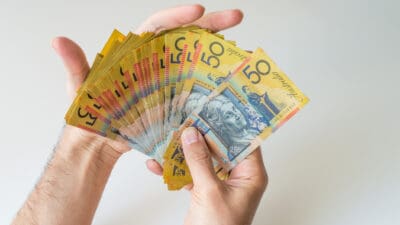ASX shares can make it easy for investors to build a portfolio that's worth a very impressive amount — even if we're talking about putting as little as $50 towards the portfolio every month.
When we think about how much money is needed to invest in a property, we're talking about a deposit of tens of thousands of dollars. Alternatively, many share brokers allow us to invest just $500 into ASX shares as a starting amount.
After four decades of investing $50 a month, people can build up a portfolio value to much more than you might expect.
Start saving
Firstly, $50 won't just magically appear in our bank accounts. We need to consciously spend less so we can save. If someone can save more than $50 per month, that's great. But just getting to $50 per month may be tricky enough for some households during this cost-of-living crisis.
But one benefit of higher interest rates is that we can earn interest in our bank accounts while we're saving towards a goal of (at least) $500 to get us started.
Invest
Once we've reached that target of $500 we can choose to invest in something.
For the sake of diversification and starting off with a solid investment, I think an exchange-traded fund (ETF) would be a good choice.
Some investors may like the idea of investing in the Vanguard Australian Shares Index ETF (ASX: VAS) because it's invested in many of the large Australian companies that we know such as National Australia Bank Ltd (ASX: NAB), Woolworths Group Ltd (ASX: WOW), and Telstra Group Ltd (ASX: TLS).
However, Australia only makes up a small part of the global economy and the ASX is a small part of the global share market. So, I'd consider the Vanguard MSCI Index International Shares ETF (ASX: VGS) which is actually invested in a portfolio of well over 1,000 names from across the world.
Due to the global growth focus of many of the companies involved in the VGS ETF, I think it's more likely to be able to deliver an average return per annum of 10% over the long term.
Over time, we could add ASX shares with good growth prospects into the portfolio, but ETFs on their own can do the job perfectly well.
Let compounding do its thing
The more that compounding does the work, the less we need to invest ourselves. That's why saving just $50 per month can build into a large portfolio value.
Over the past five years, the VGS ETF has delivered an average return per annum of 11.5%. So, let's assume in our calculations that our investing can deliver an average return of 11% per year in the future (though future returns may be quite different to that).
If we invested $50 per month and it made 11% per year (not including any bank interest earned), we'd be left with a value of around $349,000. That's a great nest egg in my eyes. If we could increase that investment to $100 per month after five or ten years, it'd build to an even larger figure.









